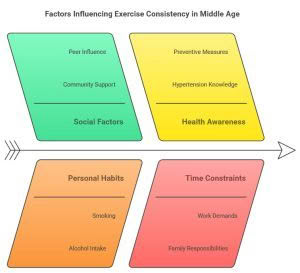Study Reveals How Much Exercise You Need Weekly To Control Your Blood Pressure
Health
Published on 06 October 2024 By: Clare Watson
When it comes to exercise for heart health, you don’t want to peak too early in life. Recent
research suggests that if you want to protect yourself against high blood pressure as you age,
you need to play the long game and keep your exercise levels up through middle age.
But social factors can make this more difficult for some people to do than others, according to
a study of more than 5,000 people across four US cities.
“Teenagers and those in their early 20s may be physically active but these patterns change with
age,” study author and epidemiologist Kirsten Bibbins-Domingo from the University of California,
San Francisco (UCSF) explained in April 2021, when the study was published in the American
Journal of Preventive Medicine.
Numerous studies have shown that exercise lowers blood pressure, but the new work suggests
that “maintaining physical activity during young adulthood – at higher levels than previously
recommended – may be particularly important” for preventing hypertension,” Bibbins-
Domingo said.
Hypertension, also known as high blood pressure, is a serious condition affecting billions of
people worldwide. It can lead to heart attack and stroke; it’s also a risk factor for developing
dementia in later life.
Upwards of one in four men and about every fifth woman has hypertension, according to the
World Health Organization. But most people with high blood pressure don’t even know they
have it – hence why it’s often called the “silent killer”.
Yet there are ways to turn high blood pressure around: exercise was the focus of this study.
Over 5,100 adults were recruited for the study, which tracked their health over three decades
with physical assessments and questionnaires about their exercise habits, smoking status, and
alcohol intake.
At each clinical assessment, blood pressure was measured three times, a minute apart, and for
the data analysis, participants were grouped into four categories, by race and gender.
Across the board – amongst men, women, and in both racial groups – levels of physical activity
slumped from 18 to 40 years of age, with rates of hypertension rising and physical activity falling
over subsequent decades.
According to the researchers, this suggests that young adulthood is an important window for
intervening to prevent midlife hypertension with health promotion programs designed to boost
exercise.
“Nearly half of our participants in young adulthood had suboptimal levels of physical activity,
which was significantly associated with the onset of hypertension, indicating that we need to
raise the minimum standard for physical activity,” said lead author Jason Nagata, a UCSF expert
in young adult medicine.
When the researchers looked at the people who had done five hours of moderate exercise a
week during early adulthood – double the minimum amount currently recommended for adults
– they found this level of activity lowered the risk of hypertension considerably, especially if
people maintained their exercise habits until age 60.
“Achieving at least twice the current minimum adult [physical activity] guidelines may be more
beneficial for the prevention of hypertension than simply meeting the minimum guidelines,” the
researchers wrote in their paper.
But it’s not easy to step up weekly physical activity amidst life-changing decisions and growing
responsibilities.
“This might be especially the case after high school when opportunities for physical activity
diminish as young adults transition to college, the workforce, parenthood, and leisure time
is eroded,” said Nagata.
As for another sobering truth, the study also showed how Black men, and Black women,
experience starkly different health trajectories compared to their White counterparts.
At 40 years of age, physical activity levels plateaued among White men and women, whereas
activity levels in Black participants continued to decline.
By 45 years, Black women surpassed White men in rates of hypertension, while White women
in the study experienced the lowest rates of hypertension through midlife.
And by age 60, between 80 to 90 percent of Black men and women had hypertension, compared
with just below 70 percent for White men and around half of White women.
The research team put these well-known racial disparities down to a multitude of social and
economic factors; not that these factors were assessed in this study, although high school
education was noted.
“Although Black male youth may have high engagement in sports, socioeconomic factors,
neighborhood environments, and work or family responsibilities may prevent continued
engagement in physical activity through adulthood,” Nagata said.
The study was published in the American Journal of Preventive Medicine.
An earlier version of this article was published in April 2021.


